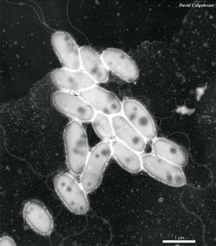Sphingomonas wittichii RW1 was isolated nearly 20 years ago from the River Elbe, Germany for its ability to completely mineralize the organic backbone of toxic dioxin pollutants (the dibenzo- p -dioxin structure), and to co-oxidize a large number of chlorinated congeners of both dibenzo- p -dioxin and dibenzofuran. These metabolic capabilities of S. wittichii RW1 are rare and potentially beneficial. Dioxin contaminants present in environments throughout the globe represent a significant threat to human and ecological health due to their bioaccumulation and biomagnification in the food chain, and their acute and chronic animal and human toxicity. Therefore, it is desirable to harness the metabolic capabilities of S. wittichii RW1 with the goal of producing an inexpensive means for the elimination of these toxins from impacted environments. S. wittichii RW1 is a member of the genus Sphingomonas , which includes strictly aerobic gram negative, asporogenous rods that produce sphingoglycolipids (SGL) of the type glucuronosyl ceramide (SGL-1). These bacteria are found in a variety of habitats including soil, sediment, oceans, and lakes where they have a profound role in the degradation of large, complex aromatic compounds associated with decaying plant matter and chemical pollution. Phylogenetically, Sphingomonas species form a tight grouping within the Alpha Proteobacteria subclass and while S. wittichii RW1 is clearly a member of this genus, in neighbor-joining trees it clusters consistently by itself, indicating distinctiveness within this group. Its nearest relative, S. yanoikuyae (previously Beijerinckia sp.), has a 16S rRNA identity of only 94% (1368 bp/1447 bp). S. wittichii is one of just a few Sphingomonas species to produce the novel sphingoglycolipid , galacturonosyl ceramide (SGL-1') in addition to the common SGL-1. Therefore, S. wittichii is the sole representative of an unexplore d branch of this important but relatively new genus. The genome sequence of S. wittichii RW1 will allow researchers to explore its proteome by mass spectrometry and to better understand the genetic basis for dioxin degradation. This is especially true given that genes for dioxin degradation are not clustered in a single operon but rather are dispersed on separate loci which suggests that the elements constituting the entire catabolic pathway for dioxin degradation have been recruited from other bacteria and/or other genetic loci, and that chromosome and plasmid encoded pathways have converged in this bacterium, thereby leading to successful dioxin degradation capabilities that are still evolving. This suggests the possibility of further enhancement of this organism's metabolic capabilities for industrial and environmental restoration applications using genome sequence information and biotechnological approaches. References: 1. Armengaud, J., B. Happe, and K. N. Timmis. 1998. Genetic analysis of dioxin dioxygenase of Sphingomonas sp. strain RW1: catabolic genes dispersed on the genome. J. Bacteriol. 180:3954-3966. 2. Halden, R. U., B. G. Halden, and D. F. Dwyer. 1999. Removal of dibenzofuran, dibenzo-p-dioxin, and 2-chlorodibenzo-p-dioxin from soils inoculated with Sphingomonas sp. strain RW1. Appl. Environ. Microbiol. 65:2246-2249. 3. Wilkes, H., R. Wittich, K. Timmis, P. Fortnagel, and W. Francke. 1996. Degradation of chlorinated dibenzofurans and dibenzo-p-dioxins by Sphingomonas sp. strain RW1. Appl. Environ. Microbiol. 62:367-371. 4. Wittich, R. M., H. Wilkes, V. Sinnwell, W. Francke, and P. Fortnagel. 1992. Metabolism of dibenzo-p-dioxin by Sphingomonas sp. strain RW1. Appl. Environ. Microbiol. 58:1005-1010. 5. Yabuuchi, E., H. Yamamoto, S. Terakubo, N. Okamura, T. Naka, N. Fujiwara, K. Kobayashi, Y. Kosako, and A. Hiraishi. 2001. Proposal of Sphingomonas wittichii sp. nov. for strain RW1(T), known as a dibenzo-p-dioxin metabolizer. Int. J. Syst. Evol. Microbiol. 51:281-292. 6. Halden, R.U., D. R. Colquhoun, and E. S. Wisniewski. 2005. Identification and Phenotypic Characterization of Sphingomonas wittichii Strain RW1 by Peptide Mass Fingerprinting Using Matrix-assisted Laser Desorption/Ionization--Time of Flight Mass Spectrometry. Appl. Environ. Microbiol. 71(5):2442-2451. |
||
|
||
Sphingomonas wittichii RW1

